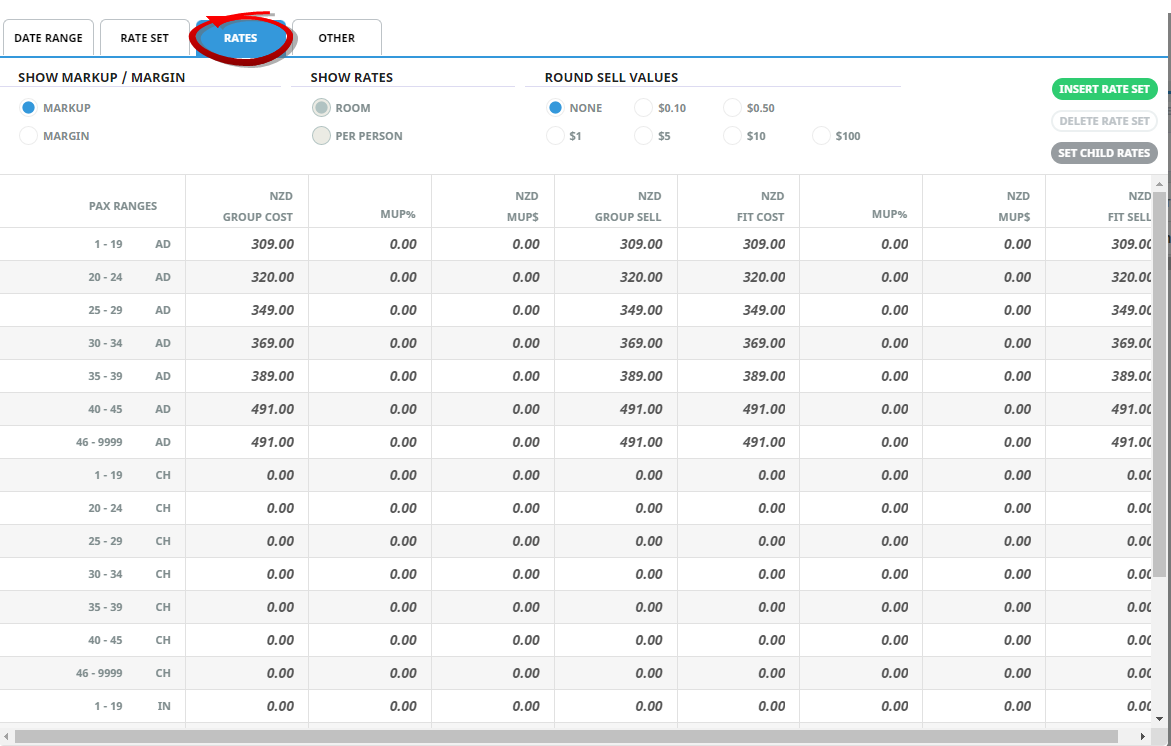Charter Coach services cater for specific vehicle sizes. When the service is selected in a booking the system will be able to correctly cost the number of vehicles required based on the number of passengers booked.
Charter Coach - Screen Overview
| Transport – Charter Coach | |
|---|---|
|
Product Setup > Product Details > General > Product Tab |
|
|
Service Category |
Non Accommodation |
|
Product Setup > Product Details > General > Price Rules Tab |
|
|
Costs Charged Per |
Per 'Coach' Per 'Day' |
|
Maximum Coach Per FCU |
Max per coach |
|
How many 24 Periods in a SCU |
1 |
| Product Setup > Product Details > General > Product Tab | |
|
Product Setup/FOC Details Tab |
|
|
FOC Quantities |
May apply to Escort and/or Guide |
|
Product Setup > Product Details > General > Pax Breaks Tab |
Insert Pax Breaks 1- XX XX-999 etc |
|
Include Children/Infants |
Should be checked to include in seat count |
|
Product Setup > Product Details > General > Voucher Tab |
|
|
Print Voucher |
As required |
|
Voucher Creation |
One voucher |
|
Product Setup > Product Details > Policies > Policies |
Pax Policy - If restrictions apply Age Policy - If required |
|
Product Setup > Rates/Rates Tab |
|
|
Rates |
Applicable Per coach per pax break pricing |
|
Product Setup > Rates/Other Tab |
|
|
Service Voucher Text 1 - 10 |
As required |
|
Product Setup > Content |
|
|
Amenities |
As required |
|
Product Notes |
As required |
|
Itinerary/Descriptive Text |
As required |
|
Product Setup > Operation |
|
|
Message Defaults/Details Tab |
Select appropriate Transport code |
Example: Transportation - Charter Coach
Price Rules Tab
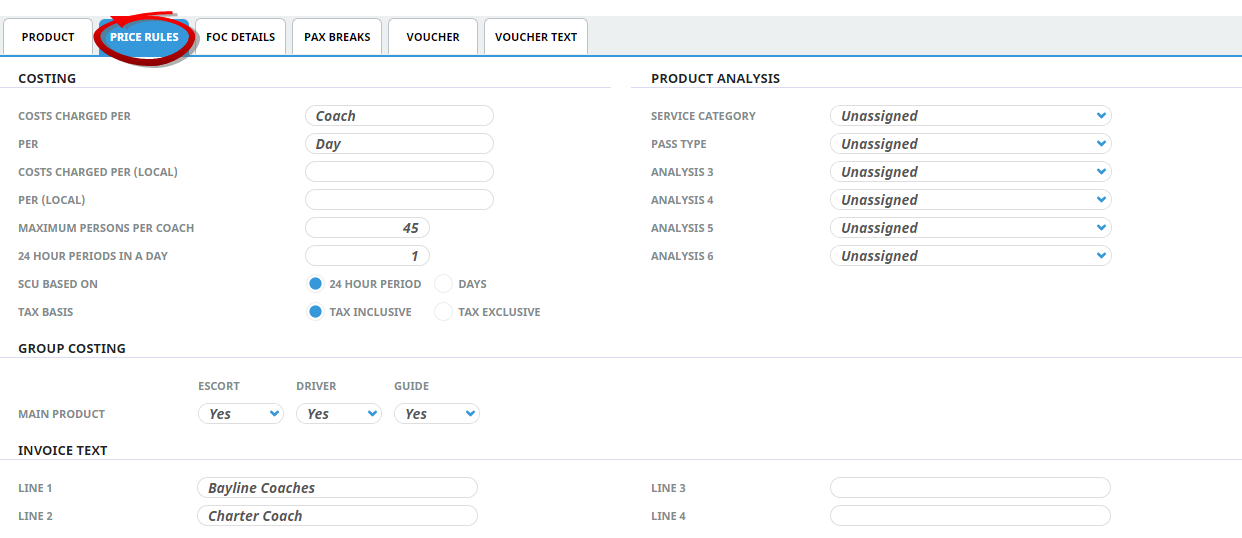
The Price Rules for the Transport service hold the First & Second Charge Units (Per Coach, Per Day) and the maximum persons per coach includes the total number of pax.
Create Coach Charter Product
The first step to inserting product is to create the shell of the product into the database, the procedures which follow on from this procedure allow further details to be inserted for this product.
Insert a Transfer Charter Product
-
Select menu
 Home > Products > Product Setup.
Home > Products > Product Setup.
-
Click
 Create New Product.
Create New Product.

-
On the
 Insert Productscreen, enter data into fields (the top three are drop-down selection fields - entries must already exist before you can select them).
Insert Productscreen, enter data into fields (the top three are drop-down selection fields - entries must already exist before you can select them).
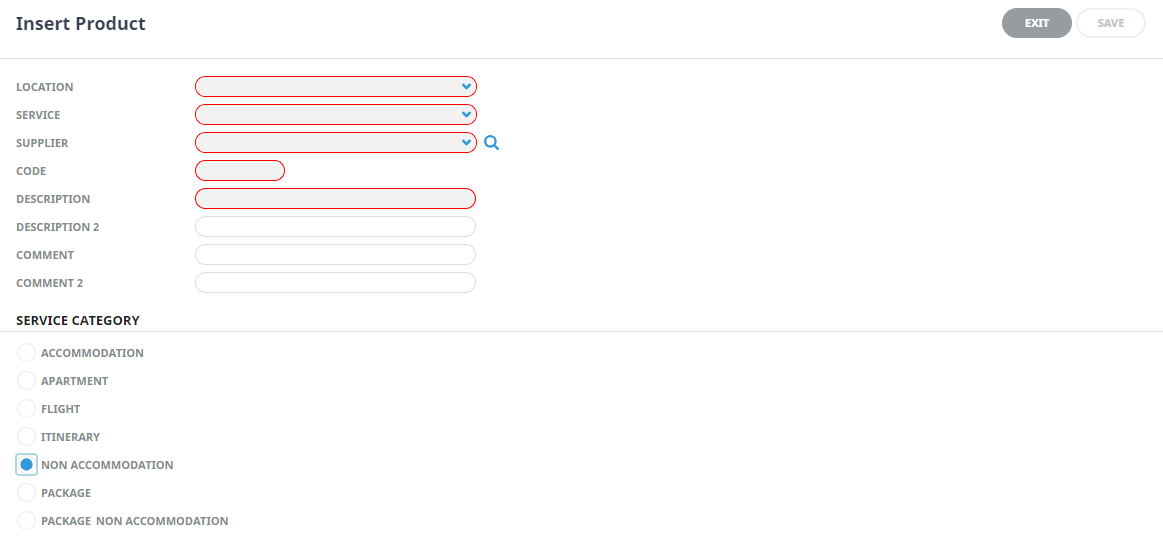
-
Check the
 completed screen.
completed screen.
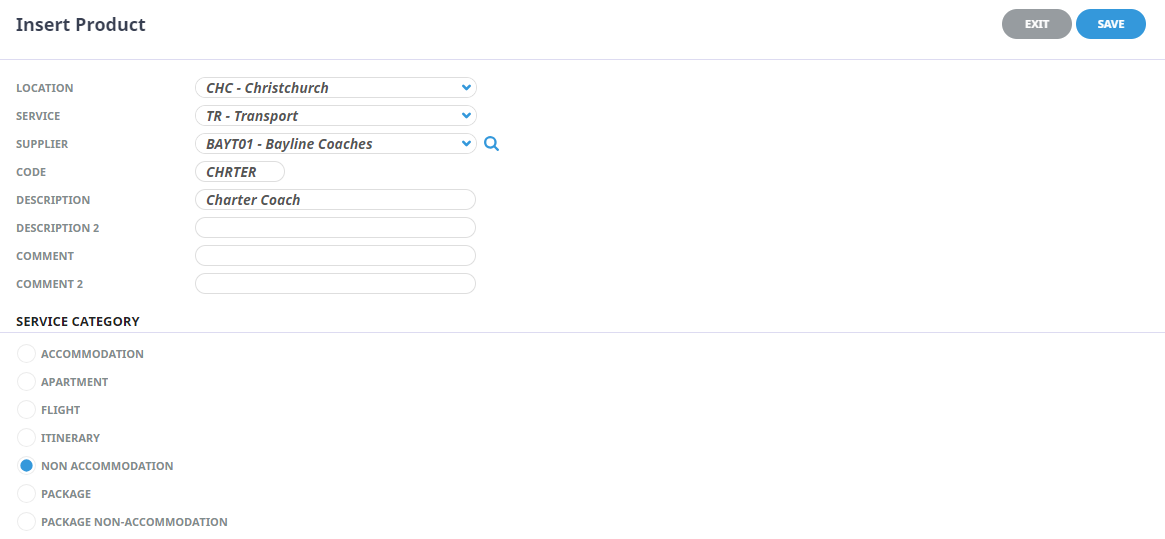
-
Click
 Save to keep the changes.
Save to keep the changes.
-
Click
 Exit to discard any changes.
Exit to discard any changes.

Location
Select a location code from the drop-down list, or type the location code. Location codes must already be setup in the Code Setup application, Create a Product Location.
Service Type
Select a service code from the drop-down list or type the Service Code. Service codes must already have been setup in the Code Setup application, Create a Product Service Type.
Supplier
Select a supplier from the drop-down list, or type the Supplier Code. Suppliers must already be setup in the Creditors application, Create a Supplier.
The search button (![]() ) to the right of the Supplier fields can be used to search based on primary search criteria of Supplier Code; Name contains; Supplier chain, plus the additional criteria of Language code; Post Code; and any of the 6 available Analysis Codes that can be attached to the supplier.
) to the right of the Supplier fields can be used to search based on primary search criteria of Supplier Code; Name contains; Supplier chain, plus the additional criteria of Language code; Post Code; and any of the 6 available Analysis Codes that can be attached to the supplier.
Code (Autocaps)
Enter a Product Code. Examples of commonly used codes are:
Non-Accommodation Admissions should try to capture the type of admission and there are no hard and fast rules for this - e.g. VIST; ADMIT. Sightseeing Tours should try to use the suppliers tour code where appropriate Rental Vehicle services can use the suppliers vehicle code - e.g. CDAR, EDMR Charter Coach could use COACH, BUS, MINIV Codes for transfers should try to convey what the transfer is - CHARTER
Each service must have these 4 key fields of Location, Service Type, Supplier and Code completed. There cannot be more than one product with exactly the same data in each of these fields. There can be multiple services for (e.g.) the same supplier, provided at least one of the key fields differs from any other service for the supplier.
It is good practice to standardise Codes. This will save time for reservations staff when locating the correct service to add to a quote or booking.
Thought should be given to how the fields Description and Comment are used. Along with most other data fields in Products, these fields are able to be output in messages and documentation. It is not uncommon for the Comments field to be used for 'in house' comment about a product - e.g. what inclusions there may be etc - so a decision will need to be made as to how these fields are going to be used - in house or publicly.
The length of both description and comments should be considered carefully to ensure that they do not exceed physical space available on (e.g.) Vouchers and Confirmations etc. Service Category The product must have one of these radio buttons checked. The service category determines what data pre-populates some of the setup fields and enables the system to use logic specific to the category to correctly generate pricing. Radio Button Definition Non-Accommodation Meals, Transfers, Sightseeing, Coach Transport, Rental Cars etc.
Price Rules
Price Rules settings identify how the service is to be sold, for example per 'person' per 'transfer', per 'person' per 'way'. Additional settings can be defined such as if the Tax is inclusive or exclusive when sold.
Insert Price Rules
- Make sure the product has already been created (see Insert an Accommodation Product).
- If the product is not already displayed, retrieve it (see Searching for Products or Suppliers).
- Identify the tab containing the fields you need to modify for the product. For this example, click the Price Rules Tab.
-
Add details to the
 Price Rules Tab fields.
Price Rules Tab fields.
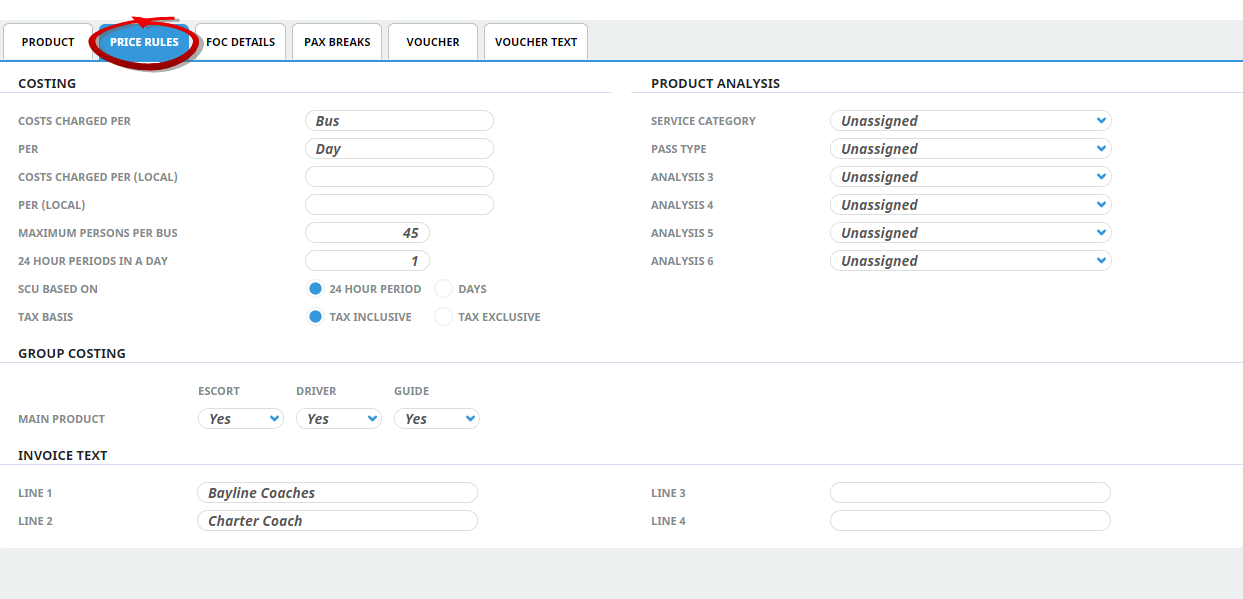
Feel free to add your own price rule configurations.
-
To keep the changes, click
 Save.
Save.
-
Click
 Discard to discard all changes.
Discard to discard all changes.

NOTE: A service using a daily rate or weekly rate would have the 'How many 24 hour periods in a ___' set to the number of 24 hour periods. For example a per coach per day service would have 'How many 24 hour periods in a day' set to 1.
Maximum Person Per
This field identifies a maximum capacity of passengers for this service. If the supplier offers a fleet of vehicles with differing passenger numbers per vehicle - a break down of passenger numbers would be inserted into the Pax Break Tab.
Pax Break Tab
Consideration for supplier transportation policies is provided within the Pax Break Tab. The main purpose for Charter Coach services is to understand if children or infants require a seat when purchasing this service. If they do require a seat and need to be included in the total booking count - the check box to 'Include Children (and/or Infants) in Pax Breaks' will need to be selected.
The other fields options in the Pax Break screen are used to provide different passenger numbers per vehicle - allowing a different rate to be inserted per vehicle size. At the time of booking or quoting, the system would look to the number of passengers booked on this service and calculate the cost using the correct vehicle size and/or number of vehicles required.
Insert Pax Breaks
- Make sure the product has already been created (see Insert an Accommodation Product).
- If the product is not already displayed, retrieve it (see Searching for Products or Suppliers).
- Identify the tab containing the fields you need to modify for the product. For this example, click the Pax Breaks Tab.
-
Add details to the
 Pax Breaks Tab fields.
Pax Breaks Tab fields.

-
To keep the changes, click
 Save.
Save.
-
Click
 Discard to discard all changes.
Discard to discard all changes.

Product Pick Up & Drop Off Localities
The Product Pick up Points menu allows alternative locations and addresses to be stored against products that have multiple pick-up and drop-off locations eg: Tour pick up locations.
Creating Pick Up and Drop Off Points
- If the supplier to which replicated locations are to be added does not exist, create the supplier first (see Create a Supplier).
- If the supplier does exist, search for the supplier from Product Setup, select menu Product Details > Pickup Points.
-
Click
 Insert to add a new entry.
Insert to add a new entry.

-
Enter the
 Locality informationand use the check boxes to assign if the locality can be used as a pick-up point and/or drop-off point and click OK to keep changes.
Locality informationand use the check boxes to assign if the locality can be used as a pick-up point and/or drop-off point and click OK to keep changes.

-
Click
 Save to keep the changes.
Save to keep the changes.
-
Click
 Exit to discard any changes.
Exit to discard any changes.

A full list of Localities will display for this product and you can review/amend the details by double clicking on the locality.
Policies Tab
Age Policy
If age policies for children and infants were the same for every service offered by the supplier, we would recommend defining age policies at a supplier level. However, if the supplier offers distinct age differences for individual services then it would be preferable to set the age policies at a product level.
Pax Policy
If the supplier has conditions of sale based on the number of passengers travelling. Product policies can define minimum and/or maximum pax requirements for non-accommodation services. If Pax Policy fields are 0, there will be no pax number restrictions.

If the number of passengers within a booking is more than 10 and less than 30 the product will show when searched, if the number of passengers is less than 10 or over 30, the product will not be visible when searched.
Insert Product Policies (or View Supplier Policies)
- Make sure the product has already been created (see Insert an Accommodation Product).
- If the product is not already displayed, retrieve it (see Searching for Products or Suppliers).
- Identify the tab containing the fields you need to modify for the product. For this example, click the Policies Tab.
-
Add details to the
 Policies Tab fields.
Policies Tab fields.
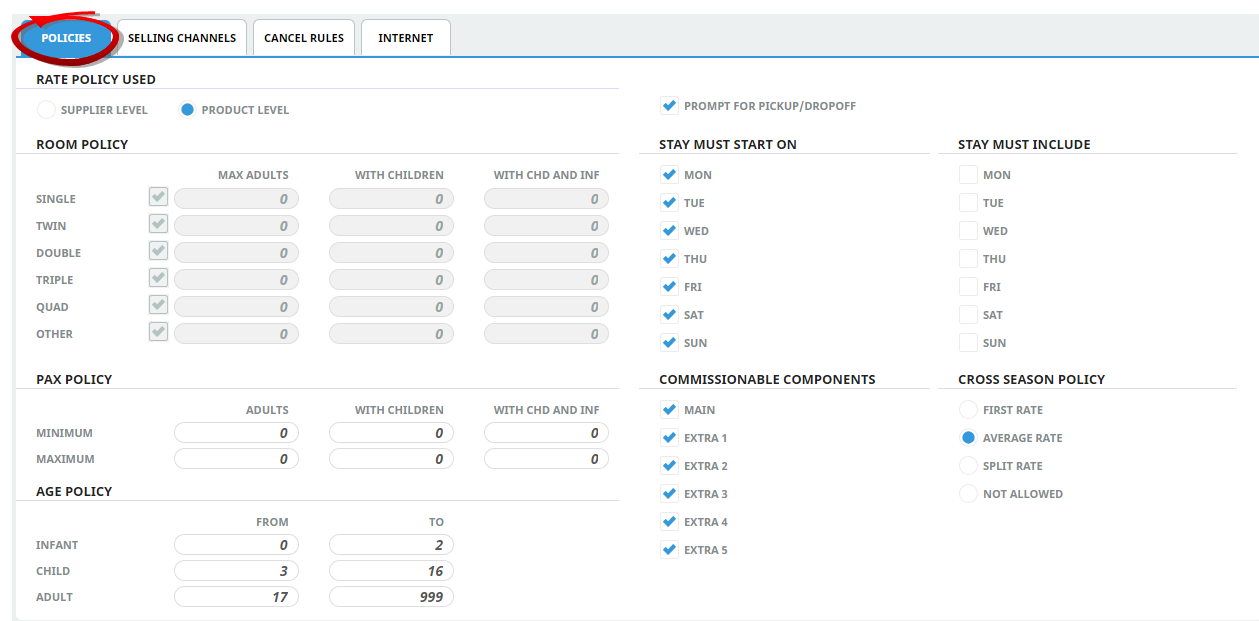
-
To keep the changes, click
 Save.
Save.
-
Click
 Discard to discard all changes.
Discard to discard all changes.

Cancel Rules Tab
Cancellation rules can be inserted at the product level (offering differing cancellation rules per service) or at the supplier level (for all services linked to the supplier).
Define Cancellation Rules
- Make sure the product has already been created (see Insert an Accommodation Product).
- If the product is not already displayed, retrieve it (see Searching for Products or Suppliers).
- Identify the tab containing the fields you need to modify for the product. For this example, click the Product Details > Policies > Cancel Rules tab.
-
Click
 Insert to add a new entry.
Insert to add a new entry.

-
On the
 Cancellation Rules screen, enter Valid From/To dates, select if the type of date in the rule is Relative or Fixed and the type of bookings the policy is for.
Cancellation Rules screen, enter Valid From/To dates, select if the type of date in the rule is Relative or Fixed and the type of bookings the policy is for.

-
The
 Service Tab will be open on screen, enter the Cancellation Fee Service Details fields.
Service Tab will be open on screen, enter the Cancellation Fee Service Details fields.
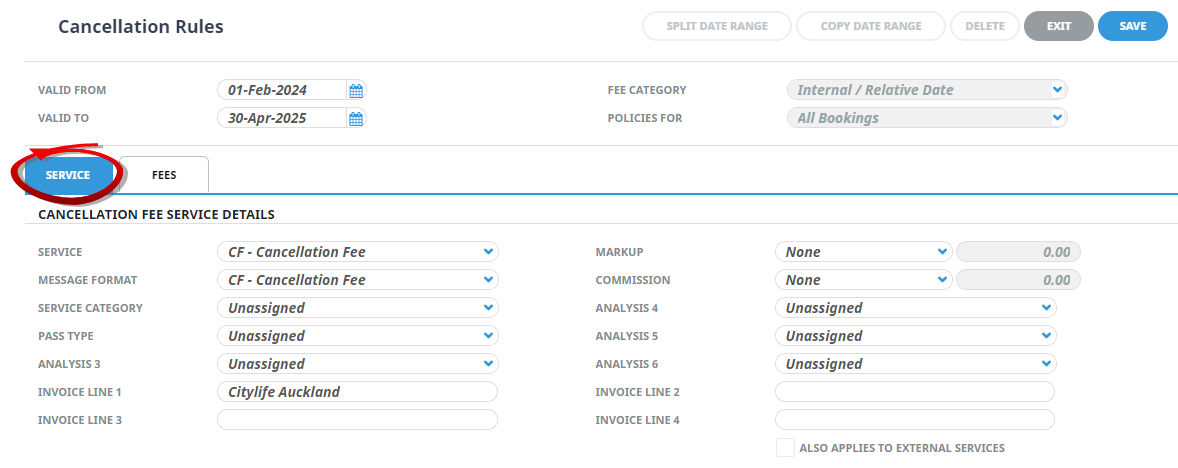
-
Click the
 Fees Tab and enter the Cancel Rule information.
Fees Tab and enter the Cancel Rule information.
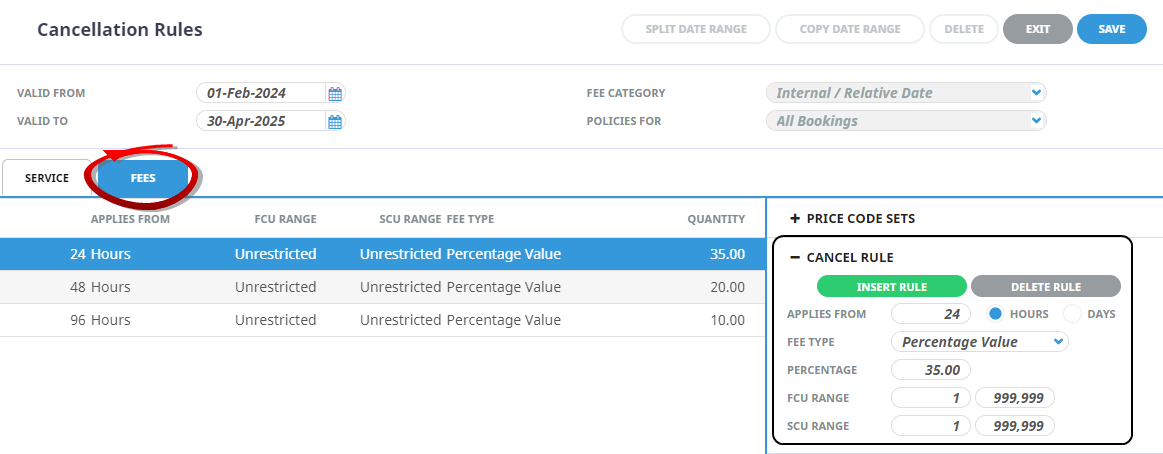
-
Click
 Insert Rule to save the rule, and insert a new rule.
Insert Rule to save the rule, and insert a new rule.

-
Click
 OK to keep the changes and save or update the entry.
OK to keep the changes and save or update the entry.

-
Click
 Delete to remove the entry and/or discard any changes.
Delete to remove the entry and/or discard any changes.

-
Click
 Exit to discard any changes.
Exit to discard any changes.

Rates
There are 4 Tabs which allow specific rate information to be stored per date range.
- Date Range - How the rate is sold? Are there specific sales periods? Will the rate be a gross rate or a nett rate? Are there any taxes which need to be defined against the rate?
- Rate Set - Are there any stay length (minimum/maximum stay) requirements? Does the rate apply for specific days? Is the rate a confirmed rate?
- Rates - The rates tab is where the rates are defined. Pax breaks used have defined pricing based on (in this example) coach size.
- Other - Allows accommodation services to include specific stay pay rules (not required for this service).
Per Bus/Coach prices are inserted into the rates screen.
Row Headings - Non Accommodation Products (Display Only)
For non accommodation products - using pax breaks, the first row will always display 'the first pax break value'.
NOTE:
- In the example being created, the 'Net Rates' price code will have no markup attached at this level; i.e., the cost and sell rates for both Group and FIT rates will be the same. Markups will be applied when a different Price Code is added to the Date Range, or the Discount Commission Matrix will be used to apply the required mark-up.
- Remember when entering the rates, if tax is involved, then the values entered into these Rate fields must reflect the Tax Inclusive/Exclusive setting from the Tax Setting section. Taxes in general are discussed in more detail under (Set Date Range Information).
